PRE-1920 BLUE GLAZES
An early Van Briggle glaze list includes: Light Blue, Turquoise, Medium Blue, Dark Blue & Navy Blue
VBPCo retains a Glaze Formula book recorded by Frank Riddle prior to 1904, with more than 20 glaze experiments included. Throughout 1912, many color glazes were used in the production of Van Briggle. When pottery ownership changed around 1913; glaze experiments were again recorded. Until 1920, a wide variety of colors were used, and VBPCo advertising frequently included the phrase, “Van Briggle….available in all the Colors of the Colorado Landscape.”
During the period of 1905-1907; a darker “chocolate” clay was sometimes in use, but not always. A light glaze application on pieces with the “chocolate” clay, with the clay showing through the high points of the design, produced a striking appearance. Two of the blue glazed dragonfly design pieces on “chocolate” clay are shown in the foreground of this picture.
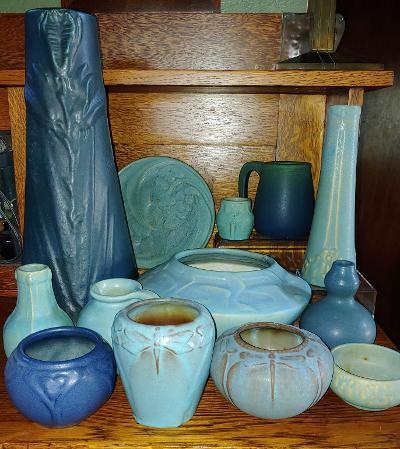
Middle Row: #835, 1907-12; #435, 1905; #512, 1906; #319E, 1905 Front Row: #514, 1906; #487, 1906; #473, 1906, #679, 1907-12
TURQUOISE MING
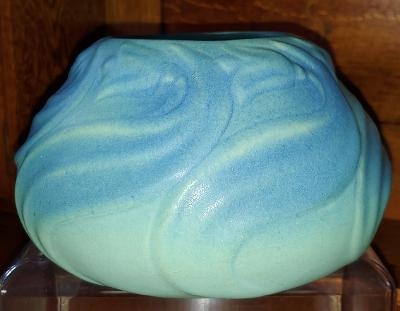
Anne Gregory Van Briggle
Jeff Stevenson explains, “Turquoise Ming, the signature glaze, actually consisted of two glazes: a base turquoise glaze (applied by dipping followed by spraying) and a blue “mottling” or overglaze (applied by spraying).
Van Briggle Pottery’s signature glaze has been called Turquoise Ming, Ming Turquoise, Ming and Blue-Green. Legend has been passed down, that Artus Van Briggle was captivated by the Ming Dynasty glaze he observed in museums while studying abroad. There has been mention of this in some early VBPCo materials, but also doubt has been cast by at least one recent researcher.
COPENHAGEN BLUE – introduced as early as 1903, again 1916, and again in 2000
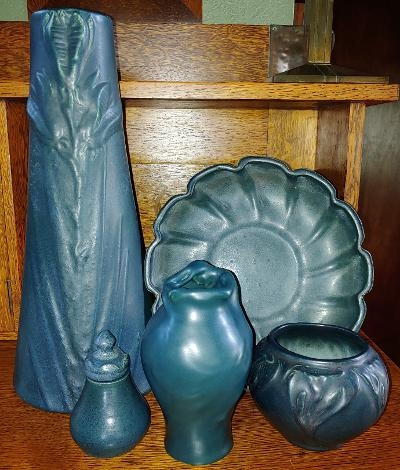
Potpourri, teens; Lorelei Repro 2000; Bowl, 1916
A Van Briggle advertisement in Vogue Magazine, dated 1916, introduced one glaze color available that year as Copenhagen Blue. Three of the above are dated 1916: the #845 Floral Bowl on right; the #951 large bowl in back, designed by Ambrose Schlegel; and the small #880 Potpourri Jar on the left.
The tall #157 Yucca Vase is dated 1903, and is one of the earliest blue glazes. The reproduction of the 1898 Lorelei was made in 2000 for the VBPCo Centennial, and in the same glaze color as one of the original 1898 Lorelei vases made by Artus Van Briggle, while in Cincinnati working for Rookwood Pottery. Too ill to work at the pottery at times, Artus produced this Lorelei at his home, using his own kiln. The piece was inscribed simply, “A. Van Briggle, 1898” but was shown at exhibition by Rookwood while Artus was studying abroad. It was always represented as an Artus Van Briggle piece, not a piece of Rookwood.
UNIDENTIFIED BLUE GLOSS – discontinued prior to 1969
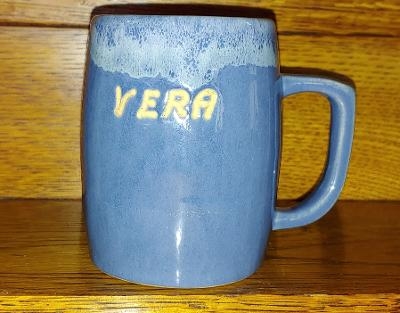
COBALT BLUE GLAZES – introduced in 1980s
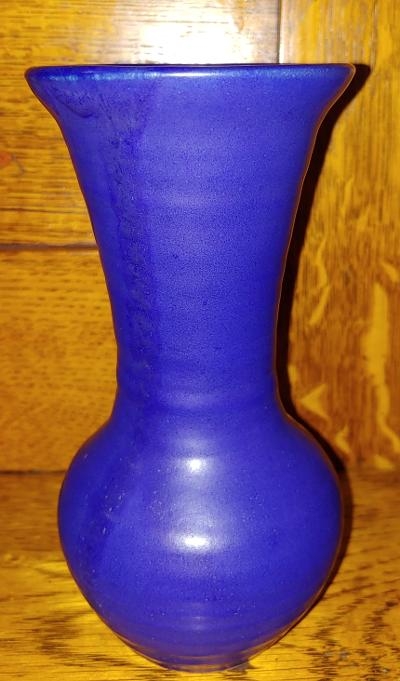
“Cs” by Craig Stevenson
Jeff Stevenson, son of the pottery owners, worked at VBPCo part-time, on Saturdays, and in the summers from age 13 until 1977. Upon graduation from the University of Missouri-Rolla (now Missouri University of Science and Technology) with a degree in Ceramic Engineering, Jeff returned to VBPCo full-time from 1977 until late 1988. He was responsible for glaze development (and troubleshooting), and also shared general management responsibilities with his father.
Jeff recalls developing the Cobalt Blue Matte Glaze some time in the 1980s; and the Cobalt Blue Gloss Glaze around the Spring of 1982, believing it was still in production when he left the company in 1988.
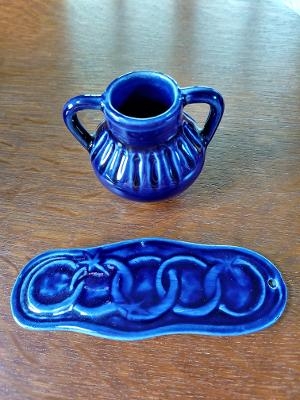
Original 2-handled vase by “Cs” Craig Stevenson and “Five Golden Rings” 12 Days of Christmas ornament designed by Craig Stevenson
ROUNDHOUSE BLUE GLAZE introduced in 2010
Information provided by Ned Tonge
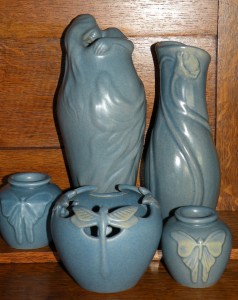
During Van Briggle Art Pottery’s relocation from the Roundhouse in the fall of 2008, a room was opened upstairs which had previously been sealed shut. When the door was pried open, the 5 ft. x 8 ft. room was found to contain a fine white powder approximately 3 feet deep. Craig Stevenson was consulted, and it was determined that this was the exhaust from the spray booth dust collection system. Under the assumption that this was all glaze material, the decision was made by Craig to collect this powder for possible future use by the company.
In May 2009, after the pottery was in operation at 1024 S. Tejon St. location, Stevenson added water to a sample of the powder and dipped a V4 (for 2004)butterfly bowl, etched by D.R. and bisque fired in 2004. The result was a higher gloss than desired, and somewhat uneven and speckled; however, it was a beautiful denim blue in color.
Stevenson granted Ned Tonge permission to continue working with the glaze. Gary Dhondt, master glazier at Van Briggle, was consulted and he taught Ned the current method of mixing and refining a small ten pound batch of the powder. Another butterfly bowl poured in red clay, etched by Candy Curtis and marked AO (for 2010) was used with this test batch. Not certain of the amount of glaze to use, Ned dipped the butterfly bowl into the glaze, drained it, and then turned it upside down and dipped it halfway again. When this was fired, the double-thick part was a beautiful matte denim blue with a speckled finish. It was then that the staff knew they had something special!
The name “Roundhouse Blue” was suggested by a long-time friend of the pottery; and the glaze was placed into limited production. Ned, Candy & Gary have produced some dramatic effects with this glaze on butterfly bowl, dragonfly, rabbit and a few other molds.
While the “exhaust spray powder” might be analyzed for reproduction; it was this 40+ year of accidental accumulation that yielded a most remarkable glaze effect! Ned Tonge
LILAC BLUE GLAZE – introduced Nov. 1993
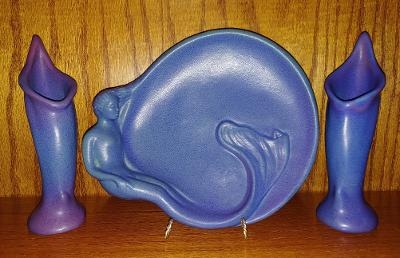
LILAC BLUE GLAZE – SIGHT SHEEN – KILN MISHAP
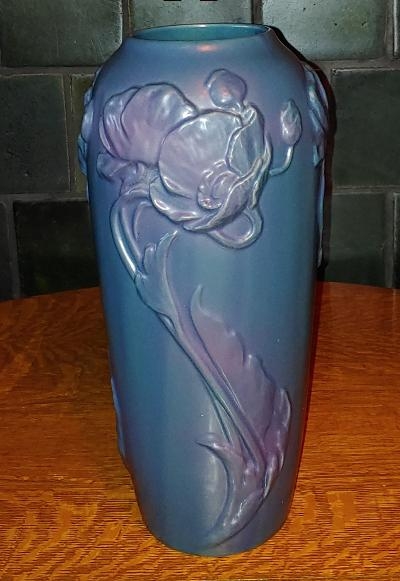
2010 Experiment by Craig Stevenson
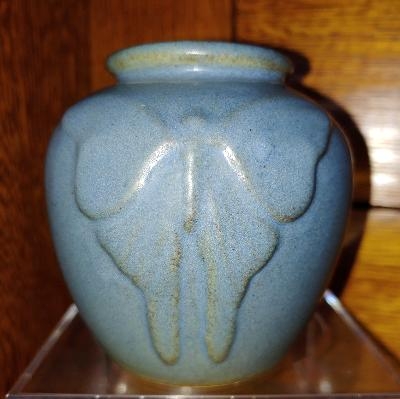
New experiment by Craig Stevenson, marked AO (2010); reminded me of the 1906 “chocolate clay” showing
through the glazes of the early years!